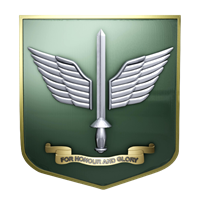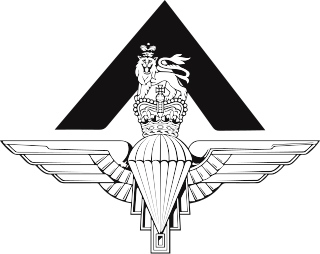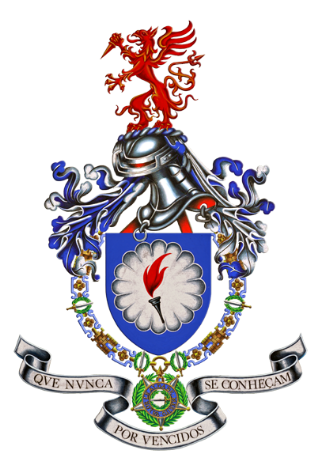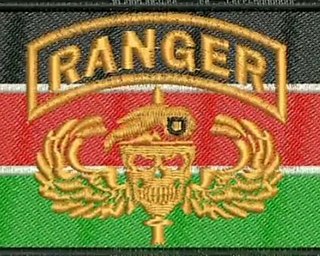
India has several Special Forces (SF) units. The three branches of the Indian Armed Forces have separate special forces units, viz. the Para SF of the Indian Army, the MARCOS of the Indian Navy and the Garud Commando Force of the Indian Air Force. There are other special forces which are not controlled by the military but operate under civilian organisations such as the Home Ministry’s National Security Guard and Research and Analysis Wing's Special Group (India). Small groups from the military SF units are deputed in the Armed Forces Special Operations Division, which has a unified command and control structure.

A parachutist badge is a military badge awarded by the armed forces of many states to soldiers who have received parachute training and completed the required number of jumps. It is difficult to assess which country was the first to introduce such an award.

The Military Freefall Parachutist Badge is a military badge of the United States Army and United States Air Force awarded to qualified U.S. Army and U.S. Air Force personnel as high-altitude military parachute specialists.

Commandos is the special forces formation of the Singapore Army responsible for conducting special operations. Commandos are tasked with infiltrating behind enemy lines by raiding and reconnaissance operations using airborne raids, helicopter assault and sea landings. The formation is made up of only one battalion, the 1st Commando Battalion, and is based in Hendon Camp.

The Parachutist Badge, also commonly referred to as "Jump Wings" is a military badge of the United States Armed Forces. The United States Space Force and United States Coast Guard are the only branches that do not award the Parachutist Badge, but their members are authorized to receive the Parachutist Badges of other services in accordance with their prescribed requirements. The DoD military services are all awarded the same Basic Parachutist Badge. The U.S. Army and U.S. Air Force issue the same Senior and Master Parachutist Badges while the U.S. Navy and U.S. Marine Corps issue the Navy and Marine Corps Parachutist Badge to advanced parachutists. The majority of the services earn their Basic Parachutist Badge through the U.S. Army Airborne School.

The Parachute Regiment is an airborne and special forces regiment of the Indian Army. It was raised in 1945 as part of the British Indian Army but was disbanded after World War II and was re-raised in 1952 as part of the Indian Army. Currently it consists of fifteen Special Forces, two Territorial Army and one Rashtriya Rifles battalions.

The Pathfinder Platoon is a pathfinder unit of the British Army, and an integral part of 16 Air Assault Brigade. The Pathfinder Platoon acts as the brigade's advance force and reconnaissance force. Its role includes locating and marking drop zones and helicopter landing zones for air landing operations. Once the main force has landed, the platoon provides tactical intelligence and offensive action roles for the brigade.

Para , also known as Para SF, are a group of special forces battalions of the Parachute Regiment in the Indian Army. These units specialize in various roles including counter-terrorism, hostage rescue,, unconventional warfare, special reconnaissance, counter-insurgency and Direct Acion,.

Lieutenant General Sagat Singh, PVSM was a General Officer in the Indian Army notable for his participation in liberation of Goa and later in Bangladesh. He held many commands and staff appointments throughout his military career.

The 10th Special Forces Group (Airborne) is an active duty United States Army Special Forces (SF) Group. 10th Group is designed to deploy and execute nine doctrinal missions: unconventional warfare (UW), foreign internal defense (FID), direct action (DA), counterinsurgency, special reconnaissance, counterterrorism, information operations, counter-proliferation of weapon of mass destruction, and security force assistance. 10th Group is responsible for operations within the EUCOM area of responsibility, as part of Special Operations Command Europe (SOCEUR).

The maroon beret in a military configuration has been an international symbol of airborne forces since the Second World War. It was first officially introduced by the British Army in 1942, at the direction of Major-General Frederick "Boy" Browning, commander of the British 1st Airborne Division. It was first worn by the Parachute Regiment in action in North Africa during November 1942.

The Regimento de Paraquedistas, based in Tancos, Portugal, is a unit of the Portuguese Army and serves as the instruction center for recruitment and training of the Portuguese paratroopers. This unit includes an entire battalion, acting as support and reserve for airborne units which contains for example, military war dogs and airborne pathfinders and an instruction battalion responsible for the forming of new paratroopers.

The Pakistan Navy Special Service Group abbreviated SSGN or simply Navy seals, is the special operations force tasked with the conducting the small-unit based military operations in all environmental formats of the sea, air, and land by adopting to the tactics of the unconventional warfare.

The 3rd Battalion, Parachute Regiment, is a battalion sized formation of the British Army's Parachute Regiment and is a subordinate unit within 16 Air Assault Brigade.

The Airborne Delivery Wing is a Royal Air Force training unit that provides parachute training to all three British Armed Forces. It is based at RAF Brize Norton. in Oxfordshire.

Special forces and special operations forces (SOF) are military units trained to conduct special operations. NATO has defined special operations as "military activities conducted by specially designated, organized, selected, trained and equipped forces using unconventional techniques and modes of employment".

The Pakistan Army Special Service Group or SSG is the special forces unit of the Pakistan Army. They are also known by their nickname of "Maroon Berets" due to their headgear.

Airborne forces raised by Australia have included a number of conventional and special forces units. During the Second World War the Australian Army formed the 1st Parachute Battalion; however, it did not see action. In the post-war period Australia's parachute capability was primarily maintained by special forces units. In the early 1980s a parachute infantry capability was revived which led to the Parachute Battalion Group forming in 1983 based on the 3rd Battalion, Royal Australian Regiment. In 1997, a full time commando regiment was raised that was able to conduct large-scale operations which matured during the 2000s. In 2011, 3 RAR relinquished the parachute role with the Army deciding to opt out of a conventional parachute capability in preference to a special forces large-scale parachute capability.

School of Infantry and Tactics is a Bangladesh army infantry and special forces training institute. The institute was founded in 1973 and is based in Jalalabad Cantonment.

The Army Special Operations Brigade is a special forces unit of the Kenyan Army, tasked with airborne operations, commando raids, reconnaissance, counter-insurgency, infiltration and other specialized forms of warfare.


















